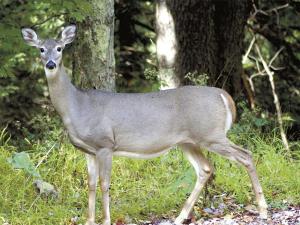There are many ways to distract deer from the garden
It has probably happened to all of us. Just as a plant is ready to bloom or set fruit, it is eaten off at the stem. Like a thief in the night, the culprit is often deer. Your likely predator is the medium-sized white-tailed deer (Odocoileus virginianus), sometimes called the Virginia deer. They can eat up to nine pounds of food every day, so they can destroy a lot of plants in a single feeding. Worse, they tend to travel in small family groups of up to eight hungry animals.
There is an upside to an invasion of whitetail deer. Their specialized stomach lets them eat things such as mushrooms that might be poisonous to humans, and even poison ivy.
At one time the word “deer” meant any wild animal. Domestic animals were all called “cattle,” and because livestock is easy to gather up and take off the land, cattle meant personal property rather than real estate or land property and gave us the modern word “chattel,” meaning personal belongings.
To keep deer at bay, you can try putting netting over shrubs and trees. The netting keeps deer from eating the trees, but still lets full sun, rain and air circulation.
Some plants are so disliked by deer that they actually keep deer away. Deer tend to avoid plnatings of black-eyed susans, daffodils, lavender, and Virginia creeper. Just remember that if food is scarce, deer will eat almost any plant.
You can plant deer-resistant shrubs such as boxwood, but don’t plant azaleas and rhododendrons, yews and euonymus, which are sometimes eaten
by deer.
In the perennial garden try planting purple coneflower (Echinacea purpurea), butterfly bush (Buddleia davidii), delphinium, lavender (Lavandula), Joe Pye weed (Eupatorium), lupines, bee balm (Monarda), catmint (Nepeta), evening primrose (Oenothera) and peony.
For the shady garden, try growing lily of the valley (Convallaria), bleeding heart (Dicentra), foxglove (Digitalis sp) and ferns such as ostrich fern (Matteuccia struthiopteris), the hay-scented fern (Dennstaedtia punctilobula) and the cinnamon fern (Osmunda cinnamomea).
Almost all spring bulbs are untouched by deer. All except tulips, which deer seem to treat as colorful candy. Instead of tulips, plant allium, chionodoxa, colchicum, crown imperial (Fritillaria imperialis), snowdrops (Galanthus), hyacinths, daffodils and jonquils (Narcissus) and Siberian squill (Scilla).
Unfortunately, deer seem to love eating the young branches of fruit trees. They can also chew the tender bark of tree seedlings. You can wrap the tree trunks in wire mesh.
Even though deer can’t see every color that we can, they can see some blues, so you are actually less visible to white tail deer in fluorescent safety orange than in blue jeans. The fluorescent safety orange actually looks like a tan to brown color to whitetail deer.
So whether you try to lure them away from your yard and garden with plantings of sweet clover or plant deer-resistant plants, you can still enjoy just watching their graceful beauty. Just be quiet and remember to wear orange.





















































